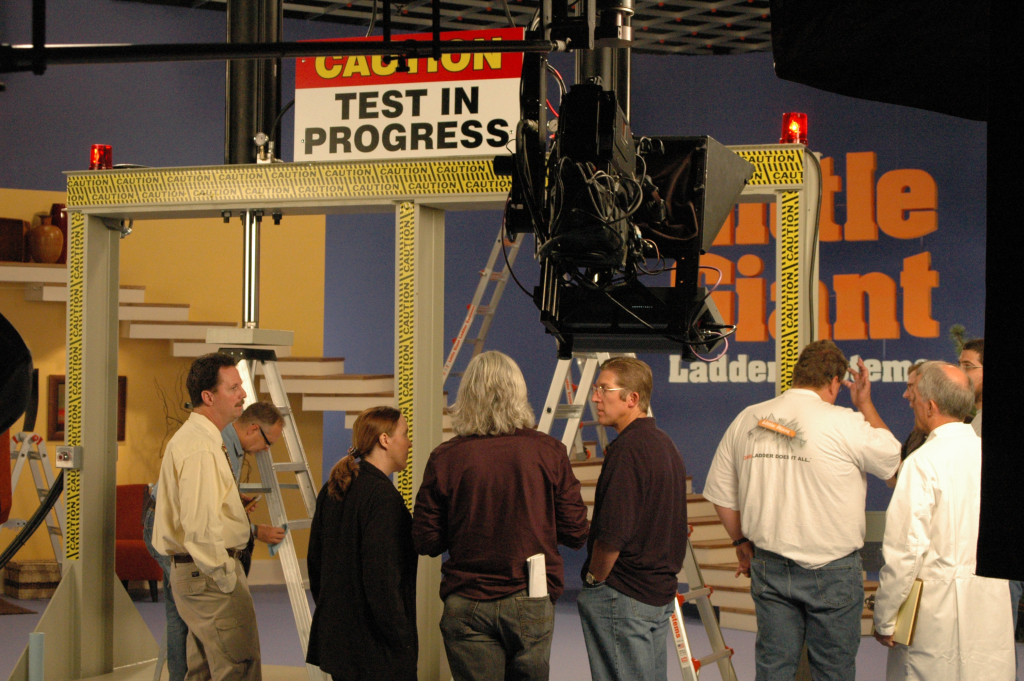Wing Men: Little Giant Ladder’s Hal and Art Wing fondly recall their company’s early beginnings and explain how direct response television helped take their ladder to new heights.
BY RICK PETRY
Yodel-Ay-Ee-Oooo may not be the first word that comes to mind when one thinks of ladders. Yet, this very call provided the breakthrough that Hal Wing needed to sell his Little Giant Ladder. Wing relates, “At the first trade show I did 28 years ago, I was really discouraged because people would come down the aisle and the first word they would say is ‘No!’” But Wing, an avowed Germanophile who had discovered the invention of painting contractor Walter Kümmerlin on a trip to Deutschland and licensed the rights to sell it in America, would not take “nein” for an answer. He strapped on lederhosen, doffed a Bavarian cap and climbed to the top of his tallest ladder where he proceeded to…yodel. While gawking passersby were still in a state of shock, Wing began demonstrating his ladder “whiz-bang” style. The ladders began to sell. It was a lesson in bold showmanship that would serve his company, Wing Enterprises, well.
Wing continued to refine the “Swiss Army Knife” of ladders out of his carport when he wasn’t honing his sales pitch by spending over 300 days a year at trade shows and fairs and sleeping in his car. One of his more memorable pitches came after he was pulled over by a pair of skeptical highway patrolmen, who didn’t believe the ladders stuffed into the back of his van belonged to him. Wing pulled out a ladder and began his frenetic demo. While the officers were convinced in short order, the road to success took longer and was paved with a few potholes.
“My dad says, the harder you work, the luckier you get,” says Art Wing, the company president and one of two of Hal’s sons who work with Wing Enterprises. He should know. Art has had a front-row seat since his adolescence doing virtually every job within the operation—from sweeping the floor to becoming a certified welder, to customer service. “I went to Ladder U,” he remarks, “and by the time I was 18, I was traveling 75,000 miles a year selling ladders beside my dad.”
Perhaps the business’ biggest rut came when Hal, whose family had now grown to a total of seven biological and adopted children, sold a stake in the company in 1981 to two partners. While the company had been humming along with modest seven-figure annual sales, Hal’s partners eventually sold a controlling interest to a conglomerate, Technical Equities. It raided the company’s credit line, eventually forcing it into bankruptcy.
After building their company through tireless roadwork, it seemed as if the Wings had walked beneath the wrong end of a ladder. But a year later, the assets of the company were put on the auction block and they took advantage of an opportunity to buy them back. “The ladder business was very fragmented; really a regional business,” Art says. And while they developed a steady business over the next decade and a half, grossing around $20 million annually, they had a new challenge: the patents on the original ladder were running out. “Our company was like a pyramid standing on a point,” Hal remembers. “We needed to flip that model upside down and have our top-of-the line ladder be the point.” It was the fall of 2002 when CEO Ryan Moss suggested a tactic that would help the Little Giant Ladder leapfrog the competition: an infomercial.
The company called DRTV expert and Barry Marketing President Bill Kittel to seek his advice about selling a $400 ladder over the television airwaves. “I thought they were crazy and tried to talk them out of it,” Kittel admits. After all, most ladders sold in hardware stores and big-box retailers were treated like a commodity, selling for around $100 to $200. But Kittel laughs, “Fortunately, I was wrong.” In the first infomercial to introduce the Little Giant Ladder, Dean Johnson and Robin Hartl of the popular home improvement show “Hometime” paired up with Hal, the whirling-dervish of a demonstrator who had honed his sales technique over the course of thousands of live presentations. The show was a hit and Little Giant Ladder sales began to grow exponentially.
The success of that first infomercial led to a second one in 2004 featuring Richard Karn, the character actor who played Tim Allen’s “Tool Time” sidekick on the wildly popular primetime hit “Home Improvement.” While Karn may have helped serve as a celebrity channel stopper, it was Art and his exuberant display of passion that made the product the real star. The success of the company’s infomercials caught the eye of the buying public, who now understood the difference between the Little Giant Ladder and pedestrian competitors. Consumer demand for the product helped grease the skids at retail, where the company has been able to maintain remarkable pricing consistency, and grow to become a category leader.
Another passion of the Wings is clearly people. While Hal is the charismatic leader on a first-name basis with everyone on the shop floor, Art, with his eye ever on the operations of Wing Enterprises, values his partners too, albeit in his own reserved way. He counts Kittel as a key strategic partner commenting, “I can’t imagine doing this without him. We’re a really good collaborative team—from writing to producing, to rollout to backend, etc.” Another key relationship is with Peter Koeppel and his namesake media-buying agency Koeppel Direct. “Koeppel has been an invaluable partner for us, easily accessible and very results oriented,” Art observes.
As their business matured, the Wings moved into a 250,000-square-foot facility in Springville, Utah, just south of Salt Lake City. It is there that over 80 different Little Giant Ladder SKUs—aimed at every segment of the marketplace from do-it-yourselfers to professional contractors—are assembled and shipped. A new studio replete with a living room and kitchen set is part of the mix so that ladder demonstrations can be filmed in a real-world setting. But perhaps most intriguing is The Innovation Room, a kind of skunk works where new ideas are incubated and hatched. As Art explains, “We’ve developed a gate system that ideas must pass through” (see chart above). The first step is a back-of-the-napkin test—and ideas are welcome from any quarter of the company. If the concept relates to a ladder innovation, its relevance is sized against the market and evaluated in terms of its cost relative to what it will fetch at retail. Next, a CAD drawing is developed that can be turned into an actual mock up of a part inside of 24 hours using a special tooling machine on the premises. From there, the new idea is beta tested before it enters the production phase and is rolled out to the consumer. But the concept of innovation isn’t just relegated to ladder features—it can also be a best practice along the production line or a way of conducting outbound business.
The result of such commitment to ingenuity is the latest product to be rolled out in the Little Giant Ladder’s new infomercial, the Select Step. The Select Step was developed in response to condo and apartment dwellers that wanted a versatile ladder that would be nimble to use and store easily. The Select Step is the first articulating step ladder that configures into five-, six-, seven- and eight-foot heights that are secured by adjustable fasteners called Rock Locks. The ladder is built with broad, flat rungs and a mini platform-like Comfort Step that allows users to stand securely while perched at the higher end of the ladder. A patented Air Deck is magnetized and holds tools in place, but it can also be used as a snap-in handle when the Comfort Deck is being used. In all, the Comfort Step, which can be easily wheeled, assumes 13 different configurations and, like its predecessor, can be used on stairs and uneven surfaces.
Its debut on TV is intended to educate consumers about the one-of-a-kind invention, and it will be followed by broad distribution of the product at retail. As Art explains, “For every ladder we sell on TV, we sell another six or seven at retail,” making retailers the ultimate beneficiary of such marketing efforts.
Now in his 70s, Hal is clearly enjoying the fruits of his success that include a magnificent car collection housed on the premises of Wing Enterprises’ plant. In a Clint Eastwood-as-mayor-of-Carmel type move, Hal took matters into his own capable hands, serving as the mayor of Springville and eliminating the city’s debt. He is unabashedly patriotic and looking into his piercing blue eyes, one gets the feeling that he’ll race over any obstacle with the same velocity and relative ease with which he drives one his many roadsters.
With his own eyes on the future, Art sees marketing as a multi-pronged endeavor involving viral, online, press, print and television among other tactics. But as they return to the DRTV airwaves after a hiatus of a few years, the Wings’ awareness of what they do best remains as steadfast as their confidence. As Art puts it, “We’re a ladder company doing an infomercial, not an infomercial company selling ladders.”
Rick Petry is a freelance writer and a past chairman of ERA. Contact Petry at (503) 740-9065, online at rickpetry.com, or follow him on Twitter at http://twitter.com/thepetrydish.





